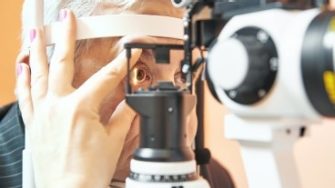
Researchers at the Centre for Eye Health have been developing and evaluating new methods for visual field testing to detect losses in glaucoma earlier than current clinical tests. Since 2016, we have published a series of research papers showing that carefully selecting a more appropriate test size identifies more defects compared to current clinical standard methods (Kalloniatis and Khuu 2016 OPO; Phu et al 2017 OPO).
In this latest paper, we have modelled functional changes across the visual field using different test sizes in order to predict when we can first detect defects prior to current tests, i.e. the lead time we gain for earlier glaucoma diagnosis. Our predictive model found that on average, we can detect visual field changes four years earlier than current tests. We confirmed this using real-world data collected from 37 patients with early glaucoma. The next steps in our research include testing it on more patients and to improve the way we match visual field data with structural measurements of the eye.
For more information, see our open access paper: Phu J, Khuu SK, Bui BV, Kalloniatis M. A method using Goldmann stimulus sizes I to V-measured sensitivities to predict lead time to visual field defect detection in early glaucoma. Translational Vision Science and Technology 2018;8:17.
